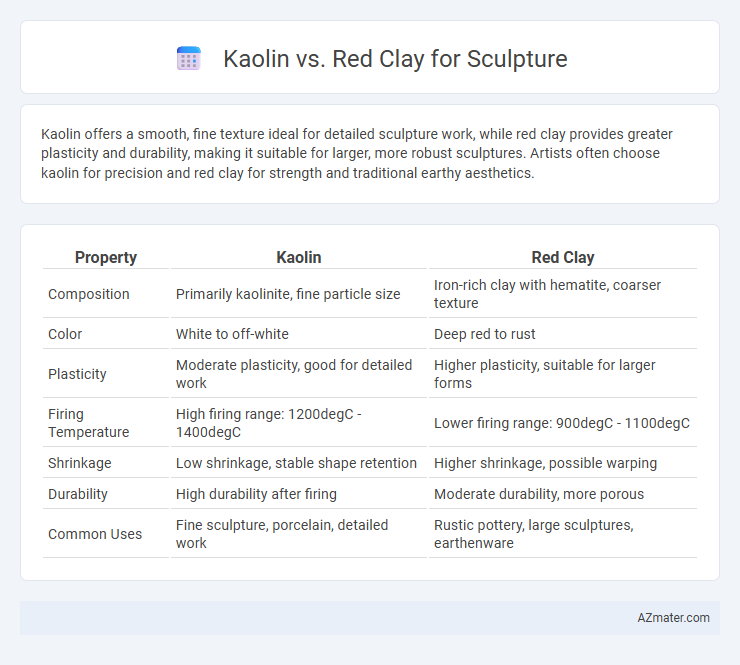Kaolin offers a smooth, fine texture ideal for detailed sculpture work, while red clay provides greater plasticity and durability, making it suitable for larger, more robust sculptures. Artists often choose kaolin for precision and red clay for strength and traditional earthy aesthetics.
Table of Comparison
| Property | Kaolin | Red Clay |
|---|---|---|
| Composition | Primarily kaolinite, fine particle size | Iron-rich clay with hematite, coarser texture |
| Color | White to off-white | Deep red to rust |
| Plasticity | Moderate plasticity, good for detailed work | Higher plasticity, suitable for larger forms |
| Firing Temperature | High firing range: 1200degC - 1400degC | Lower firing range: 900degC - 1100degC |
| Shrinkage | Low shrinkage, stable shape retention | Higher shrinkage, possible warping |
| Durability | High durability after firing | Moderate durability, more porous |
| Common Uses | Fine sculpture, porcelain, detailed work | Rustic pottery, large sculptures, earthenware |
Understanding Kaolin and Red Clay for Sculpture
Kaolin and red clay are both essential materials in sculpture, each offering unique properties suited for different artistic techniques. Kaolin, known for its fine particle size and white color, provides excellent plasticity and smooth texture, making it ideal for detailed and delicate sculpting. Red clay, rich in iron oxide, offers a coarser texture and greater durability, often preferred for larger, robust sculptures due to its natural strength and earthy hue.
Key Physical Properties Compared
Kaolin exhibits a fine particle size and high plasticity, allowing for smooth, detailed sculpting with minimal cracking after drying. Red clay contains higher iron oxide, giving it a denser, coarser texture and greater structural strength but reduced malleability compared to kaolin. Both clays have distinctive shrinkage rates during firing, with kaolin shrinking less, making it ideal for delicate sculptures requiring precision.
Workability and Sculpting Techniques
Kaolin clay offers excellent workability due to its fine particle size and smooth texture, making it ideal for detailed sculpting techniques such as carving and intricate modeling. Red clay, with its higher iron content and coarser grain, provides better plasticity and strength, suitable for hand-building methods like pinching and coiling. Sculptors often choose kaolin for precision work and red clay for durable, larger-scale pieces that require structural stability.
Color and Texture Differences
Kaolin offers a bright white color and a smooth, fine texture that is ideal for detailed sculpture work, allowing for crisp lines and delicate finishes. Red clay features a rich, earthy hue ranging from deep orange to brick red and has a coarser texture that provides a more rustic, tactile surface. The color variation in red clay also influences the firing temperature and final look, while kaolin's purity makes it versatile for glazes and high-detail casting.
Firing Temperatures and Kiln Behavior
Kaolin clay fires at higher temperatures, typically between 1200degC and 1400degC, allowing for a more durable, porcelain-like finish ideal for fine, detailed sculptures. Red clay, with a lower firing range of approximately 900degC to 1100degC, tends to vitrify at lower temperatures, resulting in a more porous and earthy texture preferred for rustic or traditional sculptural forms. Kiln behavior differs as kaolin requires a controlled, high-temperature atmosphere to prevent warping, whereas red clay is more forgiving, often exhibiting less shrinkage and thermal shock during firing.
Strength and Durability After Firing
Kaolin clay offers higher strength and durability after firing due to its pure white composition and fine particle size, resulting in dense and hard ceramic pieces resistant to cracking. Red clay, rich in iron oxide, tends to be less durable with increased porosity and a lower firing temperature, making sculptures more prone to chipping and wear over time. For sculptures requiring long-lasting structural integrity, kaolin is the preferred material.
Suitability for Detailed Work
Kaolin offers a smooth, fine-grained texture that enhances the ability to sculpt intricate details with precision and crispness in clay art. Red clay, being coarser and containing more iron oxide, tends to have a rougher surface, making it less ideal for ultra-fine detailing but excellent for more robust, expressive forms. Artists seeking high-definition sculptural work typically prefer kaolin for its superior plasticity and detail retention during drying and firing processes.
Availability and Cost Factors
Kaolin, a fine white clay, is widely available in many regions but often commands a higher price due to its purity and suitability for detailed sculpting. Red clay, abundant and inexpensive, is commonly sourced from natural deposits, making it a cost-effective choice for large-scale or practice sculptures. The cost difference largely stems from kaolin's refined texture, which demands more processing compared to the coarser, mineral-rich composition of red clay.
Environmental and Health Considerations
Kaolin clay, known for its fine particle size and low toxicity, poses fewer respiratory health risks compared to red clay, which often contains iron oxide and other minerals that may release harmful dust during sculpting. Environmental impact favors kaolin as it is typically extracted through less invasive mining processes, while red clay extraction can lead to greater soil erosion and habitat disruption due to extensive surface mining. Both clays require proper dust control and ventilation to minimize inhalation hazards, but kaolin's consistent composition offers safer long-term use for artists concerned with health and sustainability.
Choosing the Right Clay for Your Artistic Vision
Kaolin offers a smooth, fine texture ideal for detailed, delicate sculptures requiring precision and refined finish, making it perfect for porcelain-like results. Red clay, rich in iron oxide, provides a coarser texture with increased plasticity, suitable for robust, earthy forms and outdoor durability. Selecting between kaolin and red clay depends on your artistic vision's emphasis on detail versus texture and the intended use or display environment of the sculpture.

Infographic: Kaolin vs Red Clay for Sculpture
 azmater.com
azmater.com